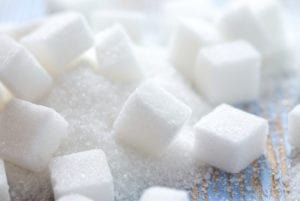Written by Jessica Patella, ND. Study results suggest that long-term, high-sugar consumption of the Western diet may play a role in attention deficits and hyperactivity disorders into adulthood.
 Is sugar addictive? Does sugar cause hyperactivity in children? These are questions that are often surrounded by much debate. On average, children, adolescents, and adults are consuming over 100 grams of sugar per day, although the World Health Organization recommends not exceeding 25 grams per day 1. Recent research found that long-term overconsumption of sugar in adolescence may be linked to persistent hyperactivity and affects the brain into adulthood 1.
Is sugar addictive? Does sugar cause hyperactivity in children? These are questions that are often surrounded by much debate. On average, children, adolescents, and adults are consuming over 100 grams of sugar per day, although the World Health Organization recommends not exceeding 25 grams per day 1. Recent research found that long-term overconsumption of sugar in adolescence may be linked to persistent hyperactivity and affects the brain into adulthood 1.
Humans often crave sugar because it can induce the release of dopamine (a pleasure neurotransmitter in the brain) in a manner that is comparable to addictive drugs 1-4. In rats, consumption of 10% sucrose or 25% glucose elicits signs of addictive behavior including, binging, tolerance, craving and symptoms of withdrawal 1,5,6. There is also increasing evidence that the high-sugar foods and beverages in the Western diet may be associated with the obesity epidemic 1,7. Correlations have also been observed between children with high sugar consumption and hyperactivity 8, as well as in adults with inattention and impulsivity 9. Due to the correlational approach to the findings, researchers used a mouse model to assess long-term intake 1.
The research began with 5-week old male mice (C57BL/6J). All the mice had food and filtered water available at all times. Two groups of mice (n=23 per group) had unrestricted access to 25% sucrose or water for 12 weeks. Sucrose and water bottles and the mice were weighed daily to measure consumption. Two other groups of mice (n=23 per group) were trained in restricted access of sugar consumption (Drinking-In-the-Dark) for 12 weeks, where mice were given access to one bottle of 25% sucrose for a 2-hour period Monday-Friday, 3 hours into the dark cycle 1.
After 5 weeks, testing of behavior and memory began in the mice for a 6-week period. After 12 weeks of sucrose drinking, the brains of the mice were then tested for neurogenesis. The results were as follows:
- The mice with unrestricted access to 25% sucrose consumed 80-90 g/kg/day and had a significant increase in overall weight starting around 4 weeks and increasing throughout the 12 weeks of exposure until reaching 10.6% overweight compared to water controls.
- Sucrose consuming mice displayed a higher general locomotor activity (increase in total distance traveled, P<0.001) and hyperactivity (increase speed, p=0.008) compared to water control animals.
- When testing memory, both episodic and spatial memory were affected by overconsumption of sugar.
- High sugar intake also decreased hippocampal cell proliferation and neurogenesis.
- In mice with restricted access to sugar (2 hours per day) there was still hyperactivity observed compared to water controls, suggesting that restricting availability does not affect the ability to resist the food. The group with restricted access to sugar did not show any changes in memory tests.
In this first study of its kind, long-term consumption of sucrose led to significant weight gain and produced significant hyperactivity and learning impairments, which was related to reduced neurogenesis (in the hippocampal region) in adult mice. Researchers stated these results suggest that long-term, high-sugar consumption of the Western diet may play a role in attention deficits and hyperactivity disorders into adulthood 1.
Source: Beecher, Kate, Ignatius Alvarez Cooper, Joshua Wang, Shaun B. Walters, Fatemeh Chehrehasa, Selena E. Bartlett, and Arnauld Belmer. “Long-term overconsumption of sugar starting at adolescence produces persistent hyperactivity and neurocognitive deficits in adulthood.” Frontiers in neuroscience 15 (2021): 567.
Click here to read the full text study.
Posted August 4, 2021.
References:
- Beecher K, Alvarez Cooper I, Wang J, et al. Long-Term Overconsumption of Sugar Starting at Adolescence Produces Persistent Hyperactivity and Neurocognitive Deficits in Adulthood. Front Neurosci. 2021;15:670430.
- Avena NM, Hoebel BG. A diet promoting sugar dependency causes behavioral cross-sensitization to a low dose of amphetamine. Neuroscience. 2003;122(1):17-20.
- Shariff M, Klenowski P, Morgan M, et al. Binge-like sucrose consumption reduces the dendritic length and complexity of principal neurons in the adolescent rat basolateral amygdala. PLoS One. 2017;12(8):e0183063.
- Klenowski PM, Shariff MR, Belmer A, et al. Prolonged Consumption of Sucrose in a Binge-Like Manner, Alters the Morphology of Medium Spiny Neurons in the Nucleus Accumbens Shell. Frontiers in behavioral neuroscience. 2016;10:54.
- Rada P, Avena NM, Hoebel BG. Daily bingeing on sugar repeatedly releases dopamine in the accumbens shell. Neuroscience. 2005;134(3):737-744.
- Colantuoni C, Rada P, McCarthy J, et al. Evidence that intermittent, excessive sugar intake causes endogenous opioid dependence. Obes Res. 2002;10(6):478-488.
- Sigala DM, Stanhope KL. An Exploration of the Role of Sugar-Sweetened Beverage in Promoting Obesity and Health Disparities. Curr Obes Rep. 2021;10(1):39-52.
- Kim Y, Chang H. Correlation between attention deficit hyperactivity disorder and sugar consumption, quality of diet, and dietary behavior in school children. Nutr Res Pract. 2011;5(3):236-245.
- Li L, Taylor MJ, Bälter K, et al. Attention-deficit/hyperactivity disorder symptoms and dietary habits in adulthood: A large population-based twin study in Sweden. American journal of medical genetics Part B, Neuropsychiatric genetics : the official publication of the International Society of Psychiatric Genetics. 2020;183(8):475-485.

